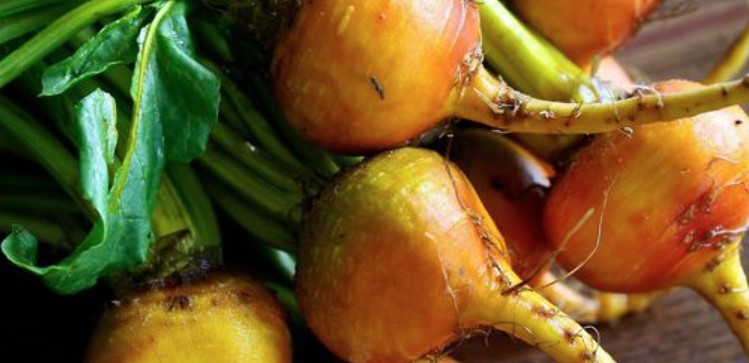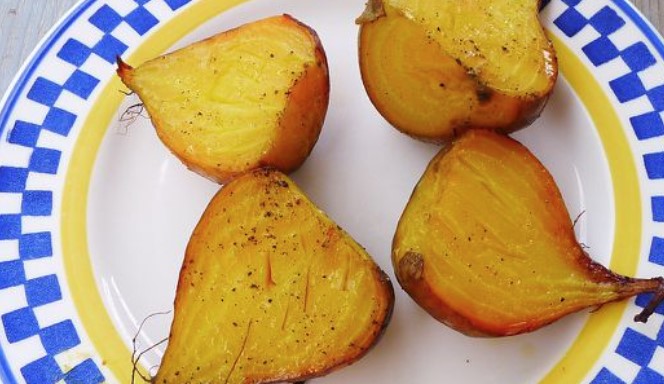Buttered turnips taste similar to swedes, but are smaller and milder. The old vegetable variety has been enjoying greater popularity again for some time. Here you can find out interesting facts about their properties as well as cultivation and use.
Butter beets are an old type of vegetable that can be found increasingly at weekly markets and in (organic) supermarkets. The butter beet belongs to the subspecies of turnips and is distinguished from other varieties such as the navette by the golden yellow color of its skin. It is therefore also known under the name “gold beet”. The taste is more comparable to the swede. The butter beet is not only smaller, it also tastes tenderer and milder.
Good to know: Despite the similarity in taste, the butter beet is not directly related to the swede. Botanically speaking, turnips are a subspecies of oilseed rape and belong to the same genus, but not the same species as turnips. However, the swede is also sometimes referred to colloquially as butter turnip – this can cause confusion.
Nutritional values and ingredients of butter beets

Turnips are generally considered to be rich in nutrients. In addition to butter beets and navettes, this subspecies also includes the small, cone-shaped Teltower turnips. The amounts of nutrients can of course vary slightly from variety to variety. On average, raw turnips contain the following basic nutritional values per 100 grams:
Calorific value: 28 kcl (117 kJ)
Protein: 0.9 grams
Fat: 0.1 grams
Carbohydrates: 6.43 grams (including 3.8 grams of sugar)
Fiber: 1.8 grams
In addition, turnips are rich in minerals. Per 100 grams they provide, among other things:
191 milligrams of potassium
67 milligrams of sodium
30 milligrams of calcium
27 milligrams of phosphorus
11 milligrams of magnesium
0.3 milligrams of iron
15 micrograms of folic acid
Vitamin C (21 milligrams) and vitamin K (0.1 micrograms) are also contained in turnips such as butter beet. For better classification: The daily requirement of vitamin C is 110 milligrams for men and 95 milligrams for women.
Butter beets: seasonal and home-grown
Butter beets can be grown as May beets, but also as autumn beets. Accordingly, the harvest time falls either in May or between October and November. Butter beets are often available from storage for up to two months after the end of the harvest.
The butter beet is an easy-care vegetable and can also be easily grown in your own garden. Depending on whether you want to harvest in May or in the fall, you should plant the seeds in late March/early April or mid-July/late August. You do this as follows:
First select a suitable location. A sunny and not too dry location is particularly important. Butter beets, on the other hand, do not make any special demands on the soil conditions.
Prepare the soil for sowing by loosening the soil a bit. If necessary, remove weeds from the bed.
Make seed furrows in the soil 30 to 40 centimeters apart. They should be an inch or two deep.
Spread the seeds evenly over the grooves, then cover them with soil.
Finally, water the seeds generously.
Butter beets do not require much care after sowing. Just make sure to water them regularly, but avoid waterlogging.
After a week, the first germs should appear. The butter beets are ready for harvest after about eight weeks. Once harvested, they will keep in a cool place for about a week or two.
The butter beet in the kitchen: this is how you use it
In the kitchen you can use the butter beet both raw and cooked. Freshly harvested butter beets taste particularly fine and mild when raw. Grated or cut into fine strips, they make a delicious raw vegetable salad, for example. You can also add them to mixed salads.
Because of the similar taste, buttered turnips are generally a good alternative to swedes. You can easily prepare many swede recipes with buttered turnips, for example the classic swede stew, a simple swede soup or an exotic swede curry.
You can also prepare butter beets as a hearty side dish or starter – for example as beet puree or steamed in a little butter or margarine. Here we present a simple recipe for spicy seasoned butter beets from the pan.
Recipe: Spicy buttered beets from the pan

Ingredients:
1 kg butter beets 4 sprigs of rosemary
30 g butter or margarine salt chili flakes
1 tbsp honey
200 ml apple juice
Directions:
Wash the butter beets under running water. Remove the stalk and root end. Peel the beets and cut them into quarters.
Wash the rosemary and shake dry.
Heat butter or margarine in a pan. Add the beets and rosemary and sauté for 3 to 5 minutes.
Then add the salt, chili flakes, honey, and apple juice to the pan. Mix everything together well.
Cover the butter beets and let them cook in the pan over low heat for about ten minutes. Remove the lid just before the end of the cooking time and let the remaining liquid boil down over high heat. Toss the vegetables occasionally to keep them from burning.
Finally, remove the rosemary sprigs and season the buttered beets with salt and chilli flakes.

























